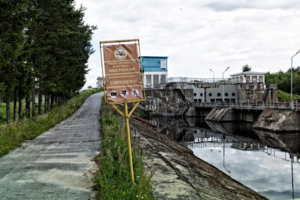Lake Kozar-Green Sea Canal
This article is incomplete because it is pending further input from participants, or it is a work-in-progress by one author. Please comment on this article's talk page to share your input, comments and questions. Note: To contribute to this article, you may need to seek help from the author(s) of this page. |
| Lake Kozar-Green Sea Canal Grand Canal | |
|---|---|
 A section of the Lake Kozar-Green Sea Canal located along the Česko-Gratislavian border | |
| Country |
|
| Specifications | |
| Maximum boat beam | 14.3 m (46 ft 11 in) |
| Maximum boat draft | 6 m |
| Status | In partial service |
| History | |
| Current owner | Various states, in dispute |
| Original owner | |
| Geography | |
| Start point | Lake Tarasov, |
| End point | Green Sea |
The Lake Kozar-Green Sea Canal (Vysokaya Rech': Озерокозар-Зеленыйобувь Kанал, Ozerokozar-Zelenoyemore Kanal) and often refered to as the Grand Canal was a ship canal constructed by the Order of Soviet Socialist Republics between 1937 and 1963 designed to connect the five great lakes of northern Omand to the Green Sea. Though the canal actually begins in Lake Tarasov, located in southern Transnapastain, it is named for the larger Lake Kozar. The canal system uses a series of man-made rivers constructed through several nation's before ultimately converging with the Xhevahir River in northern Illyria, and following its course into the Green Sea. Overall, it is X kilometers n length, corssing 5 nations/
The Grand Canal was constructed in lands either already possessed by the Soviet Order or through nation's invaded and occupied by it. The construction was mostly performed by prionsers within the Soviet penal system, prisoners of war, or civilians impressed into service by the Soviet occupation forces. In total, it is believed that over 25,000 laborers died during the 26 years of construction. At the time, the Grand Canal was the longest man-made water way on Omand, and is considered to be one of the great feats of engineering acomplished on the planet.
The canal system was heavily damaged during the Omand Continental War and has been mostly abandoned following the withdrawal of Soviet Order forces from territories through which the canal passes. It is not believed to be completely navigable by commercial ships any longer, but remains serviceable to smaller vessels in most places. Although some nations which reieved possession of various parts of the canal, such as Gratislavia, have made no effort to improve or maintain the canal works, other nations, most notably Česko, have claimed to have repaired much of the canal's infrastructure and intend to return the canal works to service within the decade.